2013 Peugeot 308 SW BL heating
[x] Cancel search: heatingPage 4 of 382

2
CONTENTS
Instrument panels 25
Warning and indicator lamps 29
Indicators 39
Instrument panel buttons 43Ventilation 61
Heating 63
Manual air conditioning 63
Rear screen demist - defrost 65
Dual-zone digital air conditioning 66
Front seats 68
Rear seats 72
Seat modularity 78
Mirrors 80
Steering wheel adjustment 82
COMFORT 61 �Π82
Remote control key 83
Alarm 87
Electric windows 89
Doors 91
Boot 94
Panoramic sunroof 95
Fuel tank 96
Misfuel prevention (Diesel) 97
ACCESS 83 �Π98
Lighting controls 99
LED lamps 101
Daytime running lamps 101
Headlamp adjustment 103
Directional lighting 104
Wiper controls 105
Automatic rain sensitive wipers 107
Courtesy lamps 108
Interior mood lighting 109
Boot lamp 109
VISIBILITY 99 �Π109
Child seats 125
ISOFIX child seats 131
Child lock 136
CHILD
SAFETY 125 �Π136 FAMILIARISATION 4 �Π22
INSTRUMENTS and
CONTROLS 25 �Π44
Screens without audio equipment 45
Screens with audio equipment 47
Retractable colour screen (Peugeot
Connect Navigation (RT6)) 52
Retractable colour screen (Peugeot
Connect Media Navigation
(NG4 3D)) 54
Trip computer 57
MULTIFUNCTION
SCREENS 45 �Π60
Interior fi ttings 110
Front armrest 113
Boot fi ttings 116
FITTINGS 110 �Π124
7
5
4
3
26
ECO-DRIVING 23 �Π24
Page 12 of 382
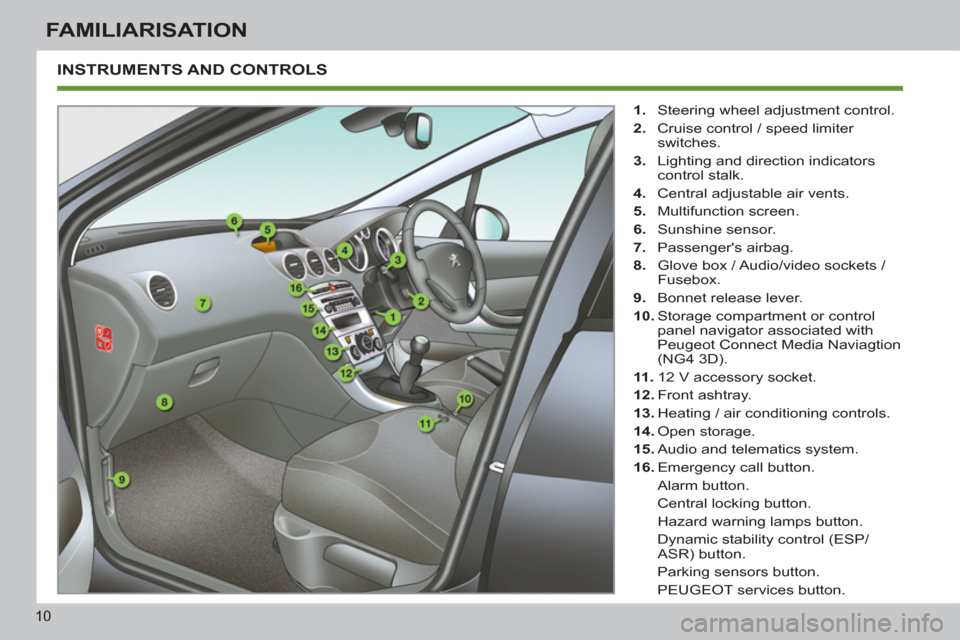
10
FAMILIARISATION
INSTRUMENTS AND CONTROLS
1.
Steering wheel adjustment control.
2.
Cruise control / speed limiter
switches.
3.
Lighting and direction indicators
control stalk.
4.
Central adjustable air vents.
5.
Multifunction screen.
6.
Sunshine sensor.
7.
Passenger's airbag.
8.
Glove box / Audio/video sockets /
Fusebox.
9.
Bonnet release lever.
10.
Storage compartment or control
panel navigator associated with
Peugeot Connect Media Naviagtion
(NG4 3D).
11 .
12 V accessory socket.
12.
Front ashtray.
13.
Heating / air conditioning controls.
14.
Open storage.
15.
Audio and telematics system.
16.
Emergency call button.
Alarm button.
Central locking button.
Hazard warning lamps button.
Dynamic stability control (ESP/
ASR) button.
Parking sensors button.
PEUGEOT services button.
Page 17 of 382
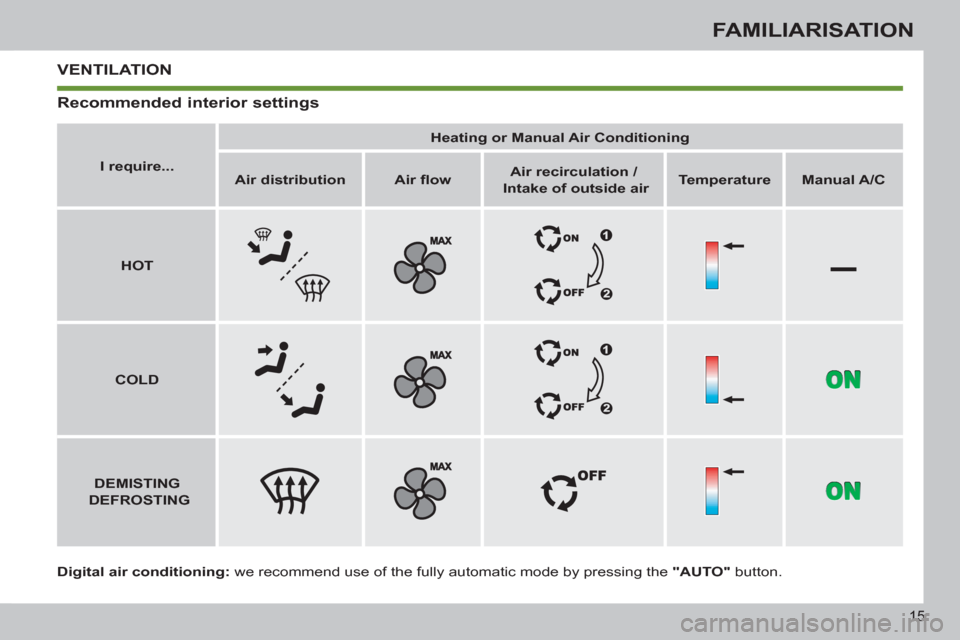
–
15
FAMILIARISATION
VENTILATION
Digital air conditioning:
we recommend use of the fully automatic mode by pressing the "AUTO"
button.
I require...
Heating or Manual Air Conditioning
Air distribution
Air fl ow
Air recirculation /
Intake of outside air
Temperature
Manual A/C
HOT
COLD
DEMISTING
DEFROSTING
Recommended interior settings
Page 38 of 382

1
36
INSTRUMENTS and CONTROLS
Warning lamp
is on
Cause
Action / Observations
Front
foglamps
fi xed. The front foglamps are
switched on. Turn the ring on the stalk rearwards twice to
switch off the front foglamps.
Rear
foglamps
fi xed. The rear foglamps are
switched on. Turn the ring on the stalk rearwards to switch off
the rear foglamps.
Diesel engine
pre-heating
fi xed. The ignition switch is at the
2nd position (ignition on).
Wait until the warning lamp has switched off before starting.
The duration for which the warning lamp is on is
determined by the climatic conditions.
Parking brake
fi xed. The parking brake is applied
or not properly released. Release the parking brake to switch off the
warning lamp, keeping your foot on the brake
pedal.
Observe the safety recommendations.
For further information on the parking brake, refer
to the "Driving" section.
Dipped beam
headlamps
fi xed. The lighting stalk is in the
"Dipped beam headlamps"
position or in the "AUTO"
position in conditions of low
light.
Main beam
headlamps
fi xed. The lighting stalk is pulled
towards you. Pull the stalk again to return to dipped beam
headlamps.
Page 63 of 382
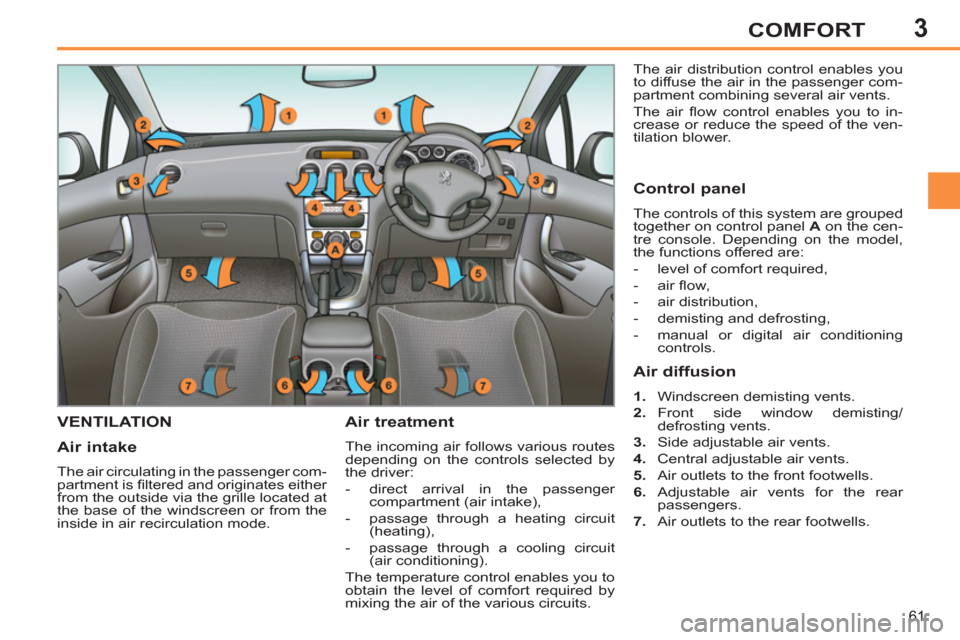
3
61
COMFORT
VENTILATION
Air treatment
The incoming air follows various routes
depending on the controls selected by
the driver:
- direct arrival in the passenger
compartment (air intake),
- passage through a heating circuit
(heating),
- passage through a cooling circuit
(air conditioning).
The temperature control enables you to
obtain the level of comfort required by
mixing the air of the various circuits. The air distribution control enables you
to diffuse the air in the passenger com-
partment combining several air vents.
The air fl ow control enables you to in-
crease or reduce the speed of the ven-
tilation blower.
Air intake
The air circulating in the passenger com-
partment is fi ltered and originates either
from the outside via the grille located at
the base of the windscreen or from the
inside in air recirculation mode.
Control panel
The controls of this system are grouped
together on control panel A
on the cen-
tre console. Depending on the model,
the functions offered are:
- level of comfort required,
- air fl ow,
- air distribution,
- demisting and defrosting,
- manual or digital air conditioning
controls.
Air diffusion
1.
Windscreen demisting vents.
2.
Front side window demisting/
defrosting vents.
3.
Side adjustable air vents.
4.
Central adjustable air vents.
5.
Air outlets to the front footwells.
6.
Adjustable air vents for the rear
passengers.
7.
Air outlets to the rear footwells.
Page 64 of 382
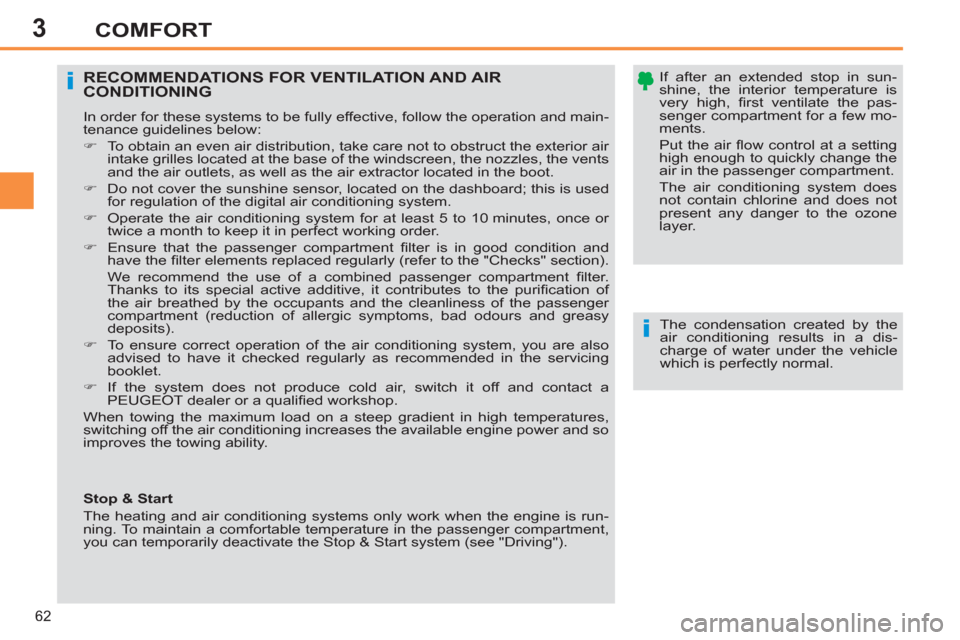
3
62
COMFORT
If after an extended stop in sun-
shine, the interior temperature is
very high, fi rst ventilate the pas-
senger compartment for a few mo-
ments.
Put the air fl ow control at a setting
high enough to quickly change the
air in the passenger compartment.
The air conditioning system does
not contain chlorine and does not
present any danger to the ozone
layer. RECOMMENDATIONS FOR VENTILATION AND AIRCONDITIONING
In order for these systems to be fully effective, follow the operation and main-
tenance guidelines below:
�)
To obtain an even air distribution, take care not to obstruct the exterior air
intake grilles located at the base of the windscreen, the nozzles, the vents
and the air outlets, as well as the air extractor located in the boot.
�)
Do not cover the sunshine sensor, located on the dashboard; this is used
for regulation of the digital air conditioning system.
�)
Operate the air conditioning system for at least 5 to 10 minutes, once or
twice a month to keep it in perfect working order.
�)
Ensure that the passenger compartment fi lter is in good condition and
have the fi lter elements replaced regularly (refer to the "Checks" section).
We recommend the use of a combined passenger compartment fi lter.
Thanks to its special active additive, it contributes to the purifi cation of
the air breathed by the occupants and the cleanliness of the passenger
compartment (reduction of allergic symptoms, bad odours and greasy
deposits).
�)
To ensure correct operation of the air conditioning system, you are also
advised to have it checked regularly as recommended in the servicing
booklet.
�)
If the system does not produce cold air, switch it off and contact a
PEUGEOT dealer or a qualifi ed workshop.
When towing the maximum load on a steep gradient in high temperatures,
switching off the air conditioning increases the available engine power and so
improves the towing ability.
The condensation created by the
air conditioning results in a dis-
charge of water under the vehicle
which is perfectly normal.
Stop & Start
The heating and air conditioning systems only work when the engine is run-
ning. To maintain a comfortable temperature in the passenger compartment,
you can temporarily deactivate the Stop & Start system (see "Driving").
Page 65 of 382
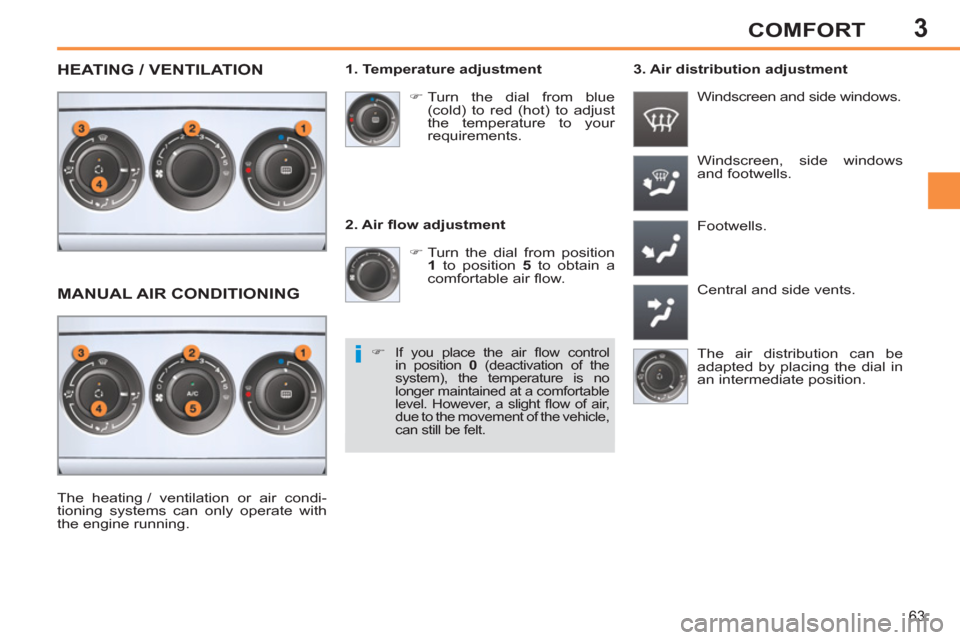
3
63
COMFORT
2. Air fl ow adjustment
�)
Turn the dial from position
1
to position 5
to obtain a
comfortable air fl ow. Windscreen, side windows
and footwells.
Footwells.
Central and side vents.
�)
Turn the dial from blue
(cold) to red (hot) to adjust
the temperature to your
requirements.
Windscreen and side windows.
1. Temperature adjustment
The air distribution can be
adapted by placing the dial in
an intermediate position.
The heating / ventilation or air condi-
tioning systems can only operate with
the engine running.
�)
If you place the air fl ow control
in position 0
(deactivation of the
system), the temperature is no
longer maintained at a comfortable
level. However, a slight fl ow of air,
due to the movement of the vehicle,
can still be felt.
3. Air distribution adjustment
HEATING / VENTILATION
MANUAL AIR CONDITIONING
Page 66 of 382
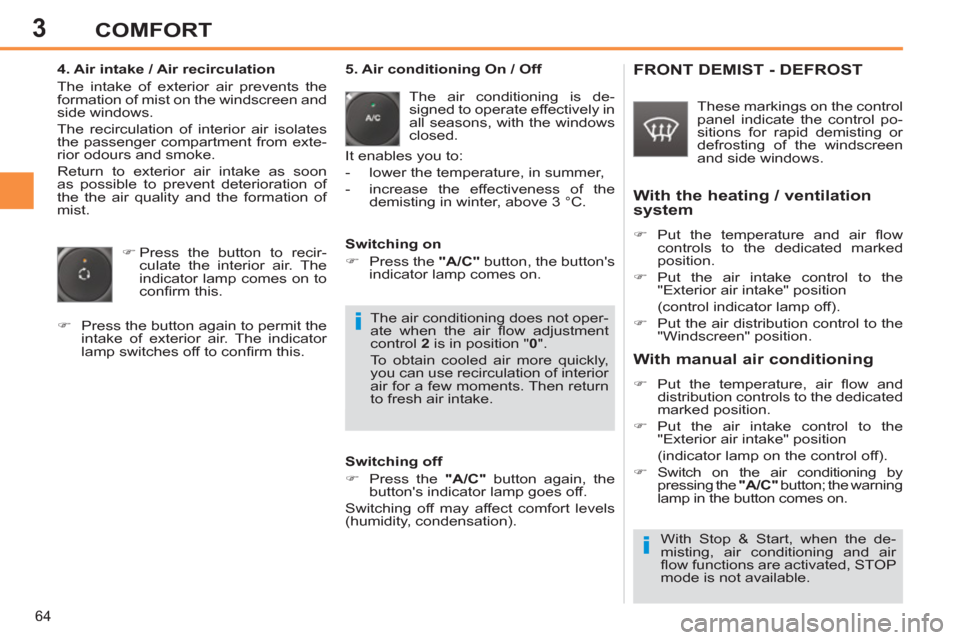
3
64
COMFORT
4. Air intake / Air recirculation
The intake of exterior air prevents the
formation of mist on the windscreen and
side windows.
The recirculation of interior air isolates
the passenger compartment from exte-
rior odours and smoke.
Return to exterior air intake as soon
as possible to prevent deterioration of
the the air quality and the formation of
mist.
�)
Press the button to recir-
culate the interior air. The
indicator lamp comes on to
confi rm this.
�)
Press the button again to permit the
intake of exterior air. The indicator
lamp switches off to confi rm this.
5. Air conditioning On / Off
The air conditioning is de-
signed to operate effectively in
all seasons, with the windows
closed.
It enables you to:
- lower the temperature, in summer,
- increase the effectiveness of the
demisting in winter, above 3 °C.
Switching off
�)
Press the "A/C"
button again, the
button's indicator lamp goes off.
Switching off may affect comfort levels
(humidity, condensation).
Switching on
�)
Press the "A/C"
button, the button's
indicator lamp comes on.
FRONT DEMIST - DEFROST
These markings on the control
panel indicate the control po-
sitions for rapid demisting or
defrosting of the windscreen
and side windows.
With the heating / ventilation
system
�)
Put the temperature and air fl ow
controls to the dedicated marked
position.
�)
Put the air intake control to the
"Exterior air intake" position
(control indicator lamp off).
�)
Put the air distribution control to the
"Windscreen" position.
With manual air conditioning
�)
Put the temperature, air fl ow and
distribution controls to the dedicated
marked position.
�)
Put the air intake control to the
"Exterior air intake" position
(indicator lamp on the control off).
�)
Switch on the air conditioning by
pressing the "A/C"
button; the warning
lamp in the button comes on.
The air conditioning does not oper-
ate when the air fl ow adjustment
control 2
is in position " 0
".
To obtain cooled air more quickly,
you can use recirculation of interior
air for a few moments. Then return
to fresh air intake.
With Stop & Start, when the de-
misting, air conditioning and air
fl ow functions are activated, STOP
mode is not available.